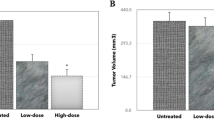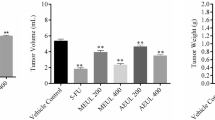Abstract
Objective
To explore the antitumor effects of ethanol extract from Ventilago leiocarpa Benth (EEVLB) on sarcoma 180 (S180) tumor-bearing mice and the potential mechanism.
Methods
Sixty mice were randomly assigned to 6 groups according to a random number table: normal group, model group, 5-fluorouracil (5-FU) group (0.02 g·kg−1), and high-, medium-, low-dose EEVLB groups (100, 84, and 56 g of raw material·kg−1 body weight, respectively), with 10 mice each group. All treatments were given once daily for 10 consecutive days. Effects of EEVLB on inhibiting tumor growth and immune function in mice were evaluated among all groups after the treatments by detecting tumor inhibition rate, organ index, serum levels of interleukin (IL)-2, -6, -10, CD3+CD4+ T lymphocytes, CD4+/CD8+ ratio, caspase-3 and Bcl-2.
Results
EEVLB with different concentrations achieved inhibition of tumor growth in vivo, wherein the high-dose group showed the most significant reduction in tumor weight and increased apoptosis of tumor cells (P<0.05). In addition, both net weight gain and spleen index of mice showed uptrend in EEVLB treatment groups (P<0.05). Besides, serum levels of IL-2 and IL-6, percentages of CD3+CD4+ T lymphocytes and ratio of CD4+/CD8+ in peripheral blood were elevated in high- and medium-dose EEVLB groups compared with the model group (P<0.05). Also, upregulation of caspase-3 and downregulation of Bcl-2 were observed at protein levels in the high-dose EEVLB group (P<0.01).
Conclusions
EEVLB exhibits promising antitumor activity in vivo. This effect might be due to activation of apoptotic signaling pathway, increase of cytokine levels and enhancement of immune function in tumor-bearing mice.
Similar content being viewed by others
References
Zhang QY, Wang FX, Jia KK, Kong LD. Natural product interventions for chemotherapy and radiotherapy-induced side effects. Front Pharmacol 2018;9:1253.
Sharifi-Rad J, Ozleyen A, Boyunegmez Tumer T, Oluwaseun Adetunji C, El Omari N, Balahbib A, et al. Natural products and synthetic analogs as a source of antitumor drugs. Biomolecules 2019;9:679.
Demain AL, Vaishnav P. Natural products for cancer chemotherapy. Microb Biotechnol 2011;4:687–699.
Lichota A, Gwozdzinski K. Anticancer activity of natural compounds from plant and marine environment. Int J Molecul Sci 2018;19:3533.
Lin CC, Lin WC, Chang CH, Namba T. Antiinflammatory and hepatoprotective effects of Ventilago leiocarpa. Phytothera Res 1995;9:11–15.
Lin LC, Chou CJ, Kuo YC. Cytotoxic principles from Ventilago leiocarpa. J Natural Product 2001;64:674–676.
Lin CC, Lin JM, Chang CH, Hattori M, Namba T. Pharmacological studies on the crude drug ‘Hwang-Jin-Guey’ from Taiwan. Phytother Res 1994;8:193–200.
Food and Drug Administration of Guangxi Zhuang Autonomous Region. Quality standards of Yao medicine in Guangxi Zhuang Autonomous Region (Volume I). Nanning: Guangxi Science and Technology Press; 2014:98–99.
Yan Z, Lai Z, Lin J. Anticancer properties of traditional Chinese medicine. Combinat Chem High Throughput Screen 2017;20:423–429.
Hu B, Wang SS, Du Q. Traditional Chinese medicine for prevention and treatment of hepatocarcinoma: from bench to bedside. World J Hepatol 2015;7:1209–1232.
Qi F, Li A, Inagaki Y, Gao J, Li J, Kokudo N, et al. Chinese herbal medicines as adjuvant treatment during chemo- or radio-therapy for cancer. BioSci Trends 2010;4:297–307.
Lind EF, Ohashi PS. Mir-155, a central modulator of T-cell responses. Eur J Immunol 2014;44:11–15.
Casati C, Dalerba P, Rivoltini L, Gallino G, Deho P, Rini F, et al. The apoptosis inhibitor protein survivin induces tumor-specific CD8+ and CD4+ T cells in colorectal cancer patients. Cancer Res 2003;63:4507–4515.
Codispoti B, Makeeva I, Sied J, Benincasa C, Scacco S, Tatullo M. Should we reconsider the apoptosis as a strategic player in tissue regeneration? Int J Biol Sci 2019;15:2029–2036.
Harikumar KB, Kuttan G, Kuttan R. Phyllanthus amarus inhibits cell growth and induces apoptosis in Dalton’s lymphoma ascites cells through activation of caspase-3 and downregulation of Bcl-2. Integr Cancer Ther 2009;8:190–194.
Jin CY, Moon DO, Choi YH, Lee JD, Kim GY. Bcl-2 and caspase-3 are major regulators in Agaricus blazei-induced human leukemic U937 cell apoptosis through dephoshorylation of Akt. Biol Pharm Bull 2007;30:1432–1437.
Kroemer G, Martin SJ. Caspase-independent cell death. Nature Med 2005;11:725–730.
Wei W, Hao EW, Zhang M, Pan XL, Qin JF, Xie JL, et al. Chemical constituents from Jasminum pentaneurum Hand.-Mazz and their cytotoxicity against human cancer cell lines. Nat Prod Res 2019; https://doi.org/10.1080/14786419.2019.1611810.
Author information
Authors and Affiliations
Contributions
Liu Y conceived and designed the study. Cheng DH and Liu Y performed the experiments and wrote the paper. Liu Y and Wang L reviewed and edited the manuscript. All authors read and approved the manuscript.
Corresponding author
Additional information
Conflict of Interest
The authors declare that there is no conflict of interest.
Supported by General Program of Guangxi Natural Science Foundation (No. 2020GXNSFAA259076), Guangxi Science and Technology Project (No. AA17202040), and Guangxi Traditional Chinese Medicine Key Discipline Construction Project (No. GZxk-z-20-75)
Rights and permissions
About this article
Cite this article
Cheng, DH., Liu, Y. & Wang, L. Antitumor Effects of Ethanol Extract from Ventilago leiocarpa Benth on Sarcoma 180 Tumor-Bearing Mice and Possible Immune Mechanism. Chin. J. Integr. Med. 27, 905–911 (2021). https://doi.org/10.1007/s11655-021-3440-4
Accepted:
Published:
Issue Date:
DOI: https://doi.org/10.1007/s11655-021-3440-4




